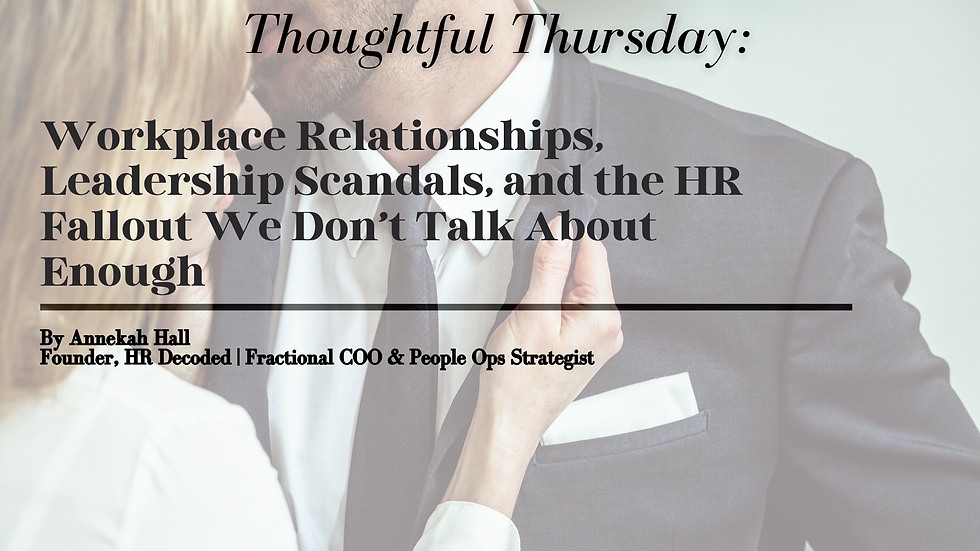Workplace Relationships, Leadership Scandals, and the HR Fallout We Don’t Talk About Enough
- Annekah Hall-Solomon
- Jul 24
- 3 min read

By now, most of you have heard about the Astronomer| Cabot scandal — a tale of workplace relationships, blurred power dynamics, and the implosion of leadership credibility. I won’t rehash the details. Frankly, the headlines have already done that.
This isn’t about the infidelity or the internet’s hot takes.
This is about something deeper: what happens when the private behavior of leaders becomes a public HR crisis, and what it reveals about the fragility of workplace trust, especially in early and growth-stage companies.
When a Relationship Becomes a Liability
Let’s get one thing straight: people are human. Attraction happens. Relationships form at work. Especially in fast-paced, close-knit environments like startups. This isn’t new. And when handled with maturity, transparency, and policy-aligned boundaries, it doesn’t have to be a problem.
But when it’s between a CEO and an employee? When the relationship is undisclosed? When there’s a power imbalance so blatant it would make an HRBP’s eye twitch?
That’s not a love story — that’s a liability.
The Astronomer situation isn’t just about one exec’s personal choices. It’s about the structural failure that allowed personal entanglements to interfere with professional judgment, accountability, and ultimately, the company’s credibility. The result? The CEO was removed, people are calling for the CHRO's resignation, and trust across the org is likely fractured in ways that an apology Slack message won’t repair.
The Real HR Nightmare: Culture Damage You Can’t Easily Undo
I’ve helped companies clean up after similar messes. And here’s what doesn’t make the headlines: the long-tail damage to morale, retention, and leadership trust.
Employees aren’t just reacting to “scandal” — they’re asking:
Who knew and said nothing?
Would I be protected if something inappropriate happened to me?
Is this what leadership really values — or just what they get away with?
If you’re a founder or exec reading this, understand: the issue isn’t just the relationship. It’s the perception of favoritism, the absence of accountability, and the erosion of psychological safety that follows when the people in charge bend the rules to serve themselves.
This is what culture erosion looks like in real-time.
The CHRO Dilemma: Caught in the Crossfire — and Still in the Chair
Kristin Cabot hasn’t resigned. While CEO Andy Byron stepped down, the CHRO remains employed, at least for now. Both were placed on leave following the viral Coldplay footage, but only one exit has been confirmed.
This raises a different, and frankly more complicated set of questions for those of us in HR and leadership circles.
What happens when the person responsible for safeguarding ethics, accountability, and workplace policy is entangled in the very behavior that undermines those standards?
This isn’t just a PR crisis, it’s a trust crisis. And when the head of HR is involved, the implications go far beyond scandal. It creates a chilling effect across the organization. Employees start to wonder: If HR won’t enforce the rules at the top, who will?
Here’s the reality: HR doesn’t just manage culture, it embodies the standard. That responsibility is heavier at the executive level, not lighter.
But let’s also name the systemic flaw here.
When the CHRO reports directly to the CEO, and the CEO is at the center of the controversy, there’s often no clean path for escalation. This is why more companies, especially those with public boards or investor oversight, are reevaluating reporting structures. Some are exploring dual-reporting models, where HR has a dotted line to the board, audit committee, or independent ethics officer.
Not because it looks good on paper.
Because without structural accountability, even the most principled HR leaders can be silenced, sidelined, or compromised.
What Founders and Leaders Should Do — Before the Scandal Hits
Let the Astronomer fallout serve as your wake-up call. Not your template for crisis response.
Here’s what smart leadership teams and HR functions should be doing now — before headlines force their hand:
Audit your conflict-of-interest and fraternization policies. Be explicit about executive relationships, reporting dynamics, and disclosure requirements.
Separate personal loyalty from professional integrity. HR leaders need the autonomy and psychological safety to challenge leadership behavior without risking retaliation.
Build governance systems that protect culture, not just the company. This includes third-party investigations, independent reporting channels, and clear board oversight.
Communicate what happens next. When a leader is removed and another is not, employees notice. Silence breeds speculation. Transparency, even if limited, builds trust.
Culture Doesn’t Die in Scandal — But It Does Evolve
If you’re navigating a leadership crisis, you’re not just managing reputations. You’re managing the emotional and psychological contract employees have with your company.
When leaders violate values, trust doesn't automatically regenerate with a resignation. It’s rebuilt in how you respond. In how you communicate. In whether the standards you preach are applied equally to everyone.
And that includes HR.
.png)



Comments